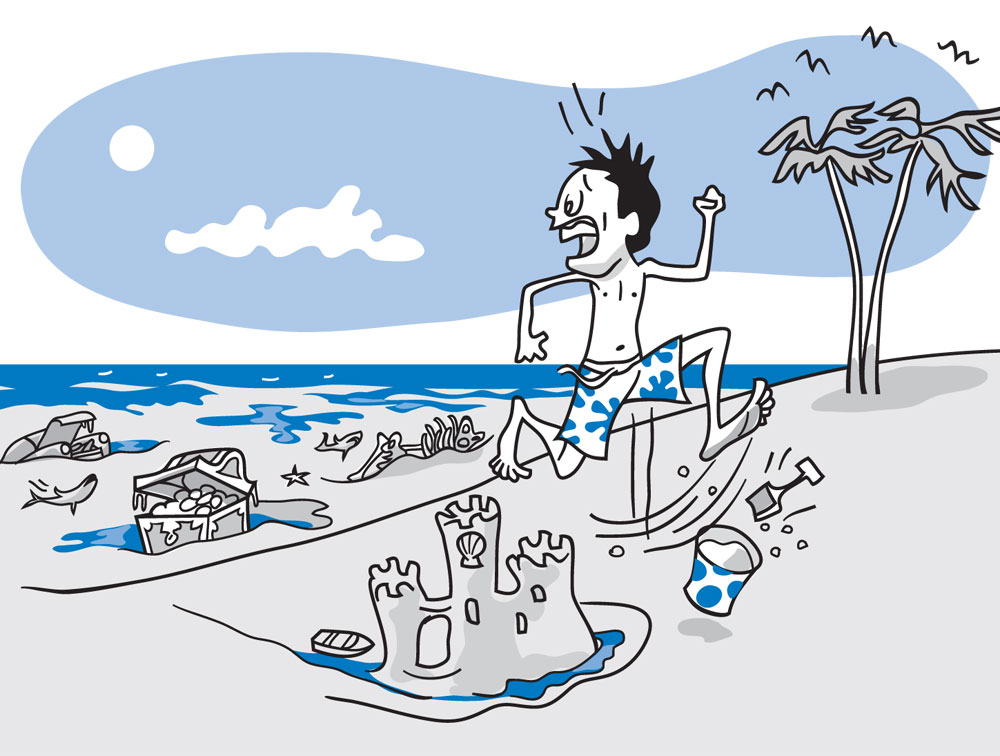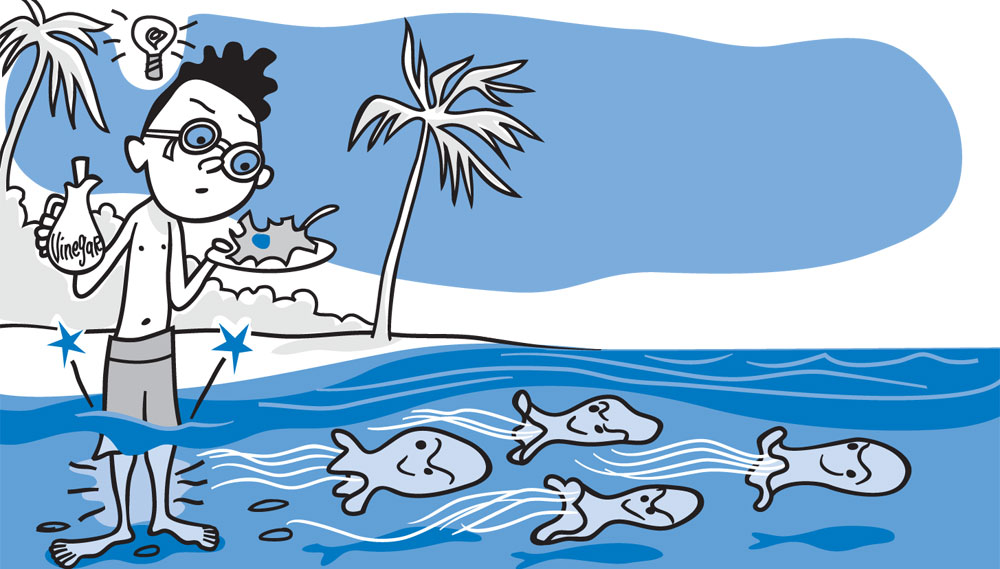

Few images spark as much fear in swimmers as a shark fin slicing through the water. Never mind that deer kill 300 times more people a year than sharks! (See Oh Deer!, page 38.) But even though shark attacks are very rare, it’s good to know what to do if Jaws drops in on your swim.
1 Stay calm.
This is sort of a given. It wouldn’t be very good advice to tell you to panic and scream like a baby, would it? The point is, just because you see a shark does not mean it will attack. Signs a shark may be getting just a little deadly include it swimming in increasingly smaller circles and rubbing its belly against the seafloor.
2 Hit it!
If a shark comes at you, you have just one choice: Fight back. Fight dirty. Go for the shark’s most sensitive spots: its eyes and gill openings. Punch, poke, and kick. This is a pro-wrestling match, and you’re the bad guy.
Keep on hitting the shark—jab it over and over in its sensitive spots. If you can convince your toothy opponent you’re too much trouble, it may look elsewhere for its lunch. After all, you wouldn’t want to eat a peanut butter and jelly sandwich that slapped you across the face, would you?
4 Get away.
Your best bet is to get on dry land, where Jaws can’t follow (at least not before another million years of evolution). If you’re in too deep (like if you’re scuba diving), try hiding in weeds or against the seafloor, where it’ll be harder for the shark to get to you.

At first, the idea of being shipwrecked on a remote island seems pretty cool—endless days frolicking on the beach. Then again, there’s no air conditioning or video games. Here’s how to get back to the real world.
1 Go logging.
Clear a path into the interior of the island and find two logs about your height and ten logs about twice your height. OK, lumberjack, now lug those babies back toward the shore. Hey, no one said this was going to be easy.
2 Live on the edge.
Place the two short logs at the edge of the water at low tide. This is important: You wouldn’t want to build the world’s greatest raft, complete with swimming pool and mini golf, only to realize you can’t get it in the water. Lay the longer logs on top of and across the shorter ones so they extend a bit past both short logs.
Here’s the hard part. You need to tie the logs together. Seaweed or vines are probably your best bet for string substitutes if you don’t have actual string. Securely tie the logs together with long lengths of vine wrapped in figure eights and as many knots as you can.
4 Surf’s up, ship out.
When the tide comes in, the water will flow under and around the raft. The raft will start to float, and you can push it out into the water. Now all you need to do is survive in the world’s biggest wave pool (see How to Survive When You’re Adrift at Sea, page 18). Good luck!

If you’re ever in a shipwreck, you’ll need your wits, your strength, and your nerves of steel. Oh, and a lifeboat would help! Once you’re adrift in the great deep blue, use these tips to steer yourself to safety.
1 Collect rainwater.
Supply your boat or raft with things that can function as containers: bottles, hollow coconuts, your World’s Greatest Grandkid mug, anything. Let them sit in the rain to collect water. Then put lids on your containers (you can make lids out of whatever is handy) so you can store the water and avoid spills. Drink small sips, not big gulps, so your body can absorb the water.
2 No loose ends.
Tie your water containers to you or the boat to make sure you don’t lose them. In fact, you may want to tie yourself to the boat so you don’t lose you.
Act like a vampire at the beach and cover your skin as much as possible to avoid sunburn and sunstroke.
4 Land ho!
If you’re in a busy area, you might be found by another ship. If not, keep your eye out for land. Even if you can’t see land, there are signs you’re nearing it:
• Birds. They’ll fly back to an island at night, so follow their lead.
• Driftwood. If it’s floating, land’s approaching.
• Murky water. Muddy water means a river’s mouth may be near—land could be just over the horizon.

Choose a sandy beach over a more dangerous rocky or coral shore. If necessary, drift along the shore until you find the perfect place to land.

Rearrange the letters in the word tsunami, and you can spell “I am nuts,” which is what you are if you stay near the ocean when one of these monster waves approaches. Learn the warning signs so you can be far away when the ten-story-high waves come crashing down.
1 Hey, wasn’t there an ocean here just now?
If the water level suddenly drops or rises for no clear reason, that’s one sign of a coming tsunami. Or maybe a giant sea creature just took a big swallow. Either way, take the water movement as a cue to get your butt out of the water—and away from the beach altogether.
2 Water-quake!
Tsunamis are caused by underwater earthquakes. If you’re on the shore and the ground begins to shake or you hear a low continuous roar, it’s time to get going. Don’t stop to grab your flippers.
Get yourself off the beach and up to a high place, like the peak of the local mountain or the top floor of a tall building.
4 Aah—aaah—tsu!!
Like sneezes, the waves of a tsunami can keep on coming. Stay high and dry till things calm down. You don’t want to end up soaked.

Imagine a mop made of stingers brushing across your body, and you’ll have an idea of what it feels like to get stung by a jellyfish. The good news is that with the right recipe, you can at least lessen the zing of that sting.
1 Please pass the saltwater.
Freshwater’s the way to go when brushing your teeth, shampooing, and just about everything else. But with a jellyfish sting, freshwater will actually make the sting feel worse, because it washes away salts that help lessen the sting. Rinse the sting with seawater.

2 Break out the vinegar.
White vinegar, to be more specific. Why treat your wound like a salad? Because of nematocysts. Nematocysts are tiny structures in the cells of jellyfish that deliver the sting by firing tiny “darts” of venom. The acid in the vinegar deactivates these beasts. Bottom line: The vinegar takes the sting out. (No need to add croutons.)
3 Remove any tentacles.
Lift, don’t scrape, any tentacles off using a stick or glove. If you scrape them off, you’ll cause more stings to occur. You already have an entire Braille alphabet of stings on you, so there’s no need for more.
4 To pee or not to pee? That is the question.
Some say peeing on a jellyfish sting will ease the pain. However, an Australian study showed that it actually caused more, not less, firing of nematocysts. So, it’s best not to pee on yourself or a friend. What a relief!
Centuries ago, sailors used the stars to keep their ships on course at night. And guess what? Those stars are still twinkling, so you can use them to figure out which way is which, whether you’re at sea or on land.
1 Take a dip.
The North Star (also known as Polaris) isn’t the brightest star, so we use other stars to locate it, like the stars of the Big Dipper. You can’t miss the Big Dipper—it looks like a big ladle that’s scooping up some star soup.
2 Use your pointers.
Focus on the two stars that form the far end of the ladle’s cup. These stars are called “pointers” because they point to the North Star. Just draw an imaginary line through the pointer stars and out across the sky, as shown on the right. The next star you’ll see is the North Star.
OK, stargazer. You’ve found the North Star. Now imagine that the North Star fell straight to the ground. Go find that fallen star. That’s where North is. Now you can figure out south, east, and west—and head in the direction you want to go!
